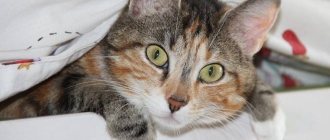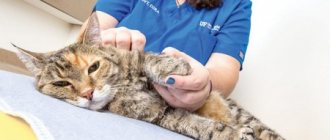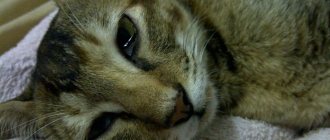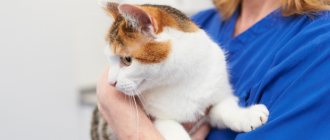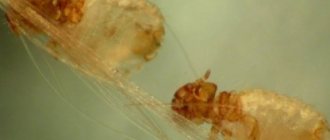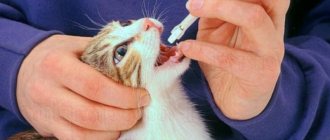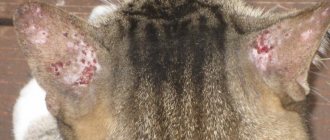When a pet appears in the house, along with it comes additional troubles related to the animal’s nutrition, care and health. A small, affectionate furball is a living creature with its own needs, character and disposition. Basically, with timely implementation of preventive measures, proper nutrition and care, there should be no problems. But if a cat often walks outside and interacts with yard animals, then diseases such as trichophytosis or ringworm may occur.
What is trichophytosis in cats and its causative agent?
Trichophytosis is a skin disease of warm-blooded animals of a fungal nature, caused by microscopic thread-like pathogenic dermatophyte fungi of the genus Trichophyton. The fungus has mycelium and reproduces by spores, which are widely distributed in the environment.
Cat owners should know what trichophytosis is and its causative agent. It is important to recognize the first clinical symptoms of the disease in time. What to do if your pet is infected with lichen and how to avoid infection?
Ringworm is characterized by severe itching, hair loss, brittleness, and the appearance of hairless areas with clear boundaries on the cat’s body. Fungal mycelium penetrates the stratum corneum of the epidermis and feeds on dead skin cells. May damage claws.
The fungus trichophyton releases toxic products during its life, destroys hair follicles, causes local skin irritation, inflammation, exudative phenomena, and purulent folliculitis.
Important! Dermatological disease is transmitted very quickly due to the persistence of fungal spores in conditions favorable to them. If treatment for your pet is not started in time, trichophytosis leads to serious systemic disorders. Severe skin damage can cause the death of a cat.
Active reproduction of dermatophyte fungi occurs in warm, humid environments. Fungal spores persist in soil for two to three years, in feces for several weeks, and in wool for up to five to six years.
Trichophyton quickly dies at high temperatures, under the influence of ultraviolet radiation, but can be resistant to certain types of chemicals and low temperatures.
Ringworm in cats occurs mainly in a chronic form. From the moment of infection it can take from several days to several months.
The risk group includes small kittens under one year old whose immune system is weakened, street stray cats, domestic cats that roam freely on the street, unvaccinated animals living in regions unfavorable for this disease.
Cats of various breeds and ages suffer from ringworm. At the same time, in kittens, old, weakened animals, trichophytosis occurs in a more severe form than in adult cats.
Interesting! Outbreaks of trichophytosis are recorded mainly in the spring and autumn-winter period, since at this time animals have reduced immunity.
Features of treatment for mild stage
An owner who discovers bald spots or fur on an animal’s skin should urgently take the pet to a specialist. This way, a serious contagious disease can be detected at an early stage. If trichophytosis is detected in cats, treatment is prescribed immediately. The course lasts quite a long time - 2 months, since the fungus has high endurance and survival.
Trichophytosis in cats at the initial stage is treated with ointments, shampoos, and sprays containing an antifungal agent. This may be the drug miconazole or thiabendazole.
Ways of transmission of the disease
The main routes of transmission of trichophytosis are contact and nutritional methods. A short contact between a healthy cat and a sick or recovered animal is sufficient. All types of warm-blooded animals are reservoirs of fungal infection.
Fungal spores can be everywhere - on grass, in soil, grass, plants, water, feed, bedding, toys, hygiene and animal care products (combs, brushes).
Trichophyton can get into the house on the owner’s clothes, shoes, or any objects with which an animal with shingles has had contact. Even if your cat does not walk outside, do not exclude the possibility of your pet becoming infected with lichen.
How cats can get infected
Infection occurs both through contact with a sick cat and through interaction with objects containing spores. The fungus can be brought home on shoes and clothing, as many stray animals are asymptomatic carriers. Rodents are also carriers of infection. A pet can also pick up a fungus during a walk, if the cat is allowed to go outside. The infection can also be contracted when visiting a veterinarian if all antiseptic rules are not followed in the hospital.
If the cat eats properly, is active and vaccinated, then the risk of developing this type of disease is low.
Symptoms and first signs
Considering that ringworm is very widespread and the dermatological infection is classified as a zoonotic disease, cat owners should be able to recognize the symptoms and first signs of a fungal infection.
Important! The duration of the incubation (hidden) period ranges from 7-10 days to three to five months. With strong immunity, a dermatological disease may not appear for several years, but the cat is a source of infection.
Ringworm has several stages and phases of development and can occur in superficial, deep, follicular forms, each of which has its own symptoms. Less commonly, cats are diagnosed with an erased or latent form of fungal infection.
Characteristic symptoms and manifestations of trichophytosis in cats:
- itching, restless behavior;
- behavior change;
- decreased activity, decreased appetite, weight loss;
- the presence on the body of round or oblong hairless lesions covered with gray-white scales;
- deterioration of coat quality, brittle wool;
- scratches, scratches, small rashes, pustules, wounds, gray-yellow crusts, scabs on the body;
- pain when palpating the affected areas of the skin;
- unpleasant odor emanating from the pet’s body;
- pallor of mucous membranes;
- fragility, separation of claws, change in their color;
- unstable temperature.
The most dangerous form of trichophytosis for cats is the deep or follicular form. Occurs with symptoms of exudative dermatitis. Under the crusts and scabs, the skin thickens, becomes wet, and pus is released.
Lesions are most often noted on the face, ears, limbs, in the croup area, on the back, and less often on the stomach of a cat with ringworm. At the beginning of the disease, hairless zones are rare and have a small diameter. Itching is absent or mild. As trichophytosis progresses, the number of lesions increases. The cat is itching. Wounds, ulcers, boils, and ulcers appear.
Important! Trichophytosis can lead to complete baldness and in this case it is almost impossible to save a sick animal. Therefore, treatment should be started as quickly as possible.
Due to severe itching, secondary microflora penetrates into the wounds. Acute inflammation develops in the superficial layers of the epidermis, which, if untreated, passes into the deep layers of the dermis.
Treatment at home
There are times when it is not possible to contact a veterinarian and you have to carry out treatment yourself, trying old-fashioned methods. In ancient times, people solved such problems on their own. For this purpose, iodine and a mixture of vegetable oil and ash were used. All affected areas were treated with a disinfectant, in this case iodine. And the gruel with ash and iodine worked like a compress. Such procedures were carried out 5-7 times a day.
To prepare the ash, newspapers, currant or raspberry branches were used. The resulting ashes were mixed with any vegetable oil that was in the house. It should be a mushy mixture. This treatment is quite effective and completely safe for the health of your pet.
With any treatment method, it is recommended to remove hair from the affected areas. This is especially important for fluffy and long-haired cats. In some cases, it is recommended to completely shave the animal so as not to miss infected areas of skin with a red rash.
Diagnosis of the disease
The diagnosis of trichophytosis is made in veterinary clinics after a number of studies and tests.
Diagnosis of the disease includes:
- full comprehensive examination of the animal;
- carrying out histological, microscopic, mycological studies;
- taking a blood test (serology);
- differential diagnosis;
- rapid tests.
For bacterial culture (sowing material onto nutrient media), wool, skin scrapings, and exudate from fungus-affected areas are sent to the laboratory. Such tests make it possible to determine the type of pathogenic fungus and its virulence. Allows you to decide on the choice of treatment methods.
The most accurate and fastest method for diagnosing trichophytosis is the luminescent method, which uses a Wood's lamp. Foci affected by the trichophyton fungus are highlighted in a light green, emerald color.
The veterinarian takes into account the medical history, clinical picture, general symptoms, and serological test data. With trichophytosis, the number of immunoglobulins in the blood decreases, the blood picture changes, and the number of leukocytes increases.
Differential diagnosis is mandatory due to the similarity of symptoms with other parasitic and dermatological infections. Trichophytosis has similar manifestations to microsporia, scab, scabies and even helminthic infestations.
Until an accurate diagnosis is made, the animal is quarantined. If your pet is infected with ringworm, be sure to visit a dermatologist.
What is ringworm?
Ringworm is a well-known name for a group of skin diseases caused by two types of pathogenic fungi: Microsporum and Trichophyton. Depending on the pathogen, medicine distinguishes between the types of this disease. Microsporia is a type of lichen caused by fungi of the genus Microsporum. Accordingly, trichophytosis is of the genus Trichophyton. But since both diseases are similar in symptoms and course, among pet owners (and not only) there is a common name for the disease - ringworm .
Treatment regimen for trichophytosis in cats, treatment methods
The treatment regimen for trichophytosis is prescribed individually and depends on the severity, degree of damage, form of fungal infection, virulence of the fungus, and age of the cat. Animals are prescribed medications for general therapy and local use.
Important! To avoid harming your cat, do not self-medicate. All medications, their dosage, and treatment regimen will be selected by the veterinarian. Special control is carried out when treating pregnant, lactating females, and weakened cats.
In the treatment of trichophytosis the following is used:
- agents that have an antifungal effect in tablets, ointments, liniments, solutions, injections;
- symptomatic medications (anti-inflammatory, wound healing, analgesics);
- homeopathy remedies;
- immunostimulants to enhance defenses, vitamin complexes (Gamavit, Vetom1.1, Neoferon, Imunofan);
- physiotherapeutic techniques.
Important! Treatment of trichophytosis is complex. On average, the course ranges from three to four weeks to 2-3 months. It all depends on the severity of the infection and the condition of the cat.
Along with medications, antiparasitic and antifungal shampoos, balms, sprays (Nizoral), antiparasitic drops, as well as alternative medicine are used. The lesions are treated with decoctions and tinctures of medicinal herbs.
During treatment, isolate the cat with deprivation from other pets and children.
To prevent your cat from licking off the applied medications, put a protective collar (Elizabethan collar) on your pet. You can make it yourself from cardboard, plastic, or buy it at a veterinary pharmacy, pet store, or veterinary clinic.
Effective Treatments
To eliminate a fungal infection, a complex of drugs is used. Most often these are drugs for topical use. Treatment may take 1 to 2 months. The required duration of therapy can be determined after passing a series of tests. Other pets must be isolated from the sick cat for 2 months.
Only a doctor should select the dosage and specific drug. Ointments and creams are applied in a thin layer to the affected areas 2-3 times a day. Antifungal agents such as Sanoderm and Mycozon give good results. Both drugs act directly on the pathogen and promote rapid healing of lesions. Local products should only be applied with gloves, otherwise there is a high risk of infection. It is recommended to wear a protective collar on the animal, which will prevent licking of the drug.
Sanoderm is an effective antifungal agent
In the complex treatment of the disease, sprays such as Exoderil and Fungin are used. These products are used after pre-treatment of the skin at the site of the lesion with furatsilin. Then a spray is applied to the lesion. Often two treatments per day are enough. The course of treatment is usually no more than 2 weeks.
Spray Fungin is used to combat trichophytosis
Fukortsin is used as an adjuvant, which has a detrimental effect on fungi and bacteria, and also promotes rapid tissue healing and eliminates inflammation. Using the solution, you need to treat already formed sores 2 times a day. For these purposes, it is best to use a cotton swab or swab. Fukortsin should be used for a week, unless otherwise recommended by your doctor.
Fukortsin promotes tissue regeneration
As the disease progresses, when local remedies do not produce results, oral medications are additionally prescribed, which have a pronounced antifungal effect. These medications include:
- Fluconazole;
- Ketoconazole;
- Intraconazole.
Fluconazole is used to treat cats infected with a fungal infection.
The listed medications are taken in the dosage prescribed by the veterinarian. You should not try to treat your pet with such remedies yourself, otherwise you may provoke negative side effects.
Local remedies, after consultation with a doctor, can be used to treat pregnant cats and kittens; oral medications are prohibited for such pets. The same note applies to the lactation period, as well as if the animal has suffered a serious illness or surgery.
If an infection occurs, antibiotic therapy may be required, which is used in the form of ointments and creams. The most common of them: Tetracycline, Erythromycin. The product is applied 2 times a day using a cotton swab in a thin layer several hours after using the antifungal drug. The course of antibiotic treatment often does not exceed a week.
A friend of mine's pet cat picked up a fungal infection. Everyone thought it was an allergy, since the doctor’s initial diagnosis was incorrect. The specialist advised using Prednisolone ointment to treat the affected areas. Surprisingly, the doctor didn’t even take any tests. Accordingly, there was no sense in the treatment. The only plus is that the cat did not scratch the lesions. As a result, they took a lot of time and all the fur came off the belly. And only at an advanced stage did a friend think of turning to another specialist, who suggested the presence of a fungal infection and appropriate treatment. I recommend that everyone contact only a trusted doctor and not resort to therapy without a diagnosis confirmed through testing.
Vaccination against trichophytosis
Timely preventive vaccination will help protect your cat from becoming infected with lichen. The veterinary drug is selected individually by a specialist. The vaccine is administered to cats twice with an interval of 14-16 days. The vaccination schedule is selected by the veterinarian.
The following vaccines are used against the fungus:
- Polivac TM.
- Vakderm.
- Mikoderm.
Vaccination against trichophytosis is used by veterinarians not only for prevention, but also for the treatment of fungal infections in cats. In case of infection, the dose of veterinary medication is doubled.
General information about the disease
Trichophytosis in cats (another name is ringworm) is an unpleasant fungal disease, a type of lichen that affects pets. The fungus spreads quickly, and its spores remain wherever the infected animal has been. The disease is caused by the fungus Trichophiton.
Rodents are considered carriers of trichophytosis. Stray cats often suffer from this disease. But domestic cats can also become infected if they have a weakened immune system, have not had regular vaccinations, or the pet is less than a year old. Moreover, trichophytosis in cats can be transmitted to humans.
The fungal pathogen is very resistant to temperatures or chemicals and is characterized by high vitality.
Disease prevention
To prevent your cat from contracting dermatological infections, disease prevention involves following basic rules.
Preventive techniques include:
- timely immunization;
- compliance with hygiene and zootechnical standards;
- creation of optimal conditions of detention;
- systematic care;
- keeping the house or apartment clean, frequent cleaning;
- organization of the nutrition system, a complete diet.
Protect your cat from adverse factors that weaken the body. Supplement your natural diet with complex vitamin complexes to activate your defenses. Pay attention to your pet's hygiene. Treat fur against ectoparasites.
If your cat is walking outside, inspect the body for damage after the walk. If there are wounds or scratches, treat them with an antiseptic.
How does a fungal infection occur?
A prerequisite for the development of a fungal infection is the contact of fungal spores and hair cells. The spores then begin to germinate on the surface of the skin and penetrate the hair follicles. A fungal infection, destroying the surface of the hair, penetrates deeper. At the same time, the animal’s fur loses its shine, the hair becomes brittle and begins to break off. At the site where the fungus grows, the animal’s skin becomes inflamed and begins to itch. Elements of fungi enter the lymph and blood, spread throughout the body, causing the emergence of new foci of infection.
Rules for cleaning an apartment or house
If your pet has had trichophytosis, it is important to know the rules for cleaning an apartment or house. This will avoid re-infection and protect you from fungal infections.
Mandatory:
- Carry out a general wet cleaning of your home using disinfectants and household chemicals. Pay special attention to the places where your cat spends the most time.
- Steam all clothing and upholstered furniture.
- Burn the cat's bed, bedding, and fur.
- Buy your cat a new house, hygiene and grooming equipment.
- Rinse food and water bowls well. Disinfect toys and tray.
Do kittens get infected and how to treat them?
Kittens, like adult animals, are susceptible to infection. Treatment in this case is provided only with local agents for 2–3 weeks. The earlier therapy is started, the higher the likelihood of a quick recovery. To treat kittens and pets whose weight does not exceed 2 kg, Furacilin solution is most often used, as well as antifungal drugs: Fungin, Sanoderm, etc. It is important to ensure that the kitten does not lick the medicine. To do this, you can put a special protective blanket on it. Before each application of antifungal ointment or cream, it is necessary to clean the lesion using a Furacilin solution (0.02%), which is easy to prepare yourself.
Furacilin has an antiseptic effect
If there are several animals in the house, the infection can easily spread. It is important to isolate pets from contact with each other and regularly carry out wet cleaning using chlorine-containing products.
Additionally, special shampoos that produce an antifungal effect are used to treat kittens. These include Imaverol, Lime Sulfer, etc. Such products are not cheap, but they allow you to get good results. These shampoos should be used once a week for 2 months. The kitten should first be rinsed with warm water (39 degrees). Then apply a little shampoo to the entire surface of the coat and lather. Leave for a few minutes and rinse with water. To prevent the kitten from catching a cold, you need to wrap it in a towel and close all the windows.

